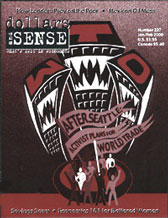Global Economic Inequality
This article is from the January/February 2000 issue of Dollars and Sense: The Magazine of Economic Justice available at http://www.dollarsandsense.org

This article is from the January/February 2000 issue of Dollars & Sense magazine.
Subscribe Now
at a 30% discount.
As the calendar turns to the year 2000, the best guide to the real Y2K crisis is not yet another glossy article on computer glitches, but the tenth annual edition of the United Nations Human Development Report. The 1999 Report is both an indispensable guide to the human condition at the turn of the century and an important attempt to raise consciousness about the grossly absurd way the world’s resources are now distributed. For instance:
- The world’s richest 20% now pocket 86% of the world’s gross domestic product; the middle 60% has just 13%; and the poorest 20% have but 1%. The income gap between the top fifth and the bottom fifth is now 74 to 1, compared to just 30 to 1 in 1960.
- 1.3 billion people—over one-fifth of the world’s population—lack access to clean water; 1.3 billion people live on less than one dollar a day; 840 million people are malnourished. According to the United Nations Hunger Project, roughly 24,000 people a day die from hunger-related causes.
- The assets of the world’s 200 richest people more than doubled between 1994 and 1998, to over $1 trillion. The world’s three richest people have assets, the report notes, greater than the combined economic output of the 48 poorest countries.
- Fifty-five nations have seen real per capita incomes decrease over the last decade.
Simply reporting these basic facts helps check our tendency to accept as normal the highly abnormal world in which we live, especially for those who do not experience economic hardship firsthand. Yet even more stunning than the simple facts of human poverty and growing inequality is how easy it would in fact be to make serious, rapid progress toward complete eradication of global poverty.
In 1997, for instance, the Human Development Report noted that for just $40 billion a year, basic health and nutrition, basic education, reproductive health and family planning services, and water sanitation services could be extended to the entire world’s population. That figure, equivalent to roughly 15% of the annual Pentagon budget, totals less than one-fifth of one percent of the world’s income. As the 1999 Report observes, "a yearly contribution of 1% of the wealth of the 200 richest people could provide universal access to primary education for all ($7-8 billion.)" A 5% contribution would suffice to provide a full complement of social services universally.
And, it might be added, in a world where $1.5 trillion a day crosses borders via international financial transactions, a simple tax of 0.1% on such transactions for one month would raise about $45 billion—more than enough to carry out the core of the UN’s antipoverty agenda.
Forty billion dollars amounts to about 0.5% of the annual gross domestic product of the United States; a relatively minor adjustment in priorities could yield an incredible human achievement—the universal provision of basic social services. In fact, the UN has estimated that a well-spent $80 billion would suffice to provide not only basic social services but also income transfers sufficient to lift all of the world’s poorest people out of conditions of extreme poverty.
